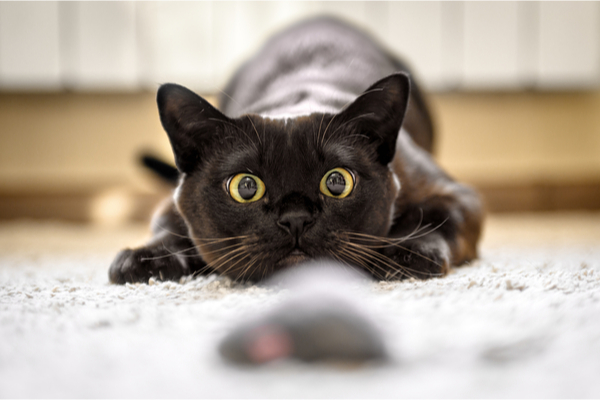Cats senses are more heightened than those of their humans. As The Daily Paws reports, cats are both predators and prey animals, and therefore need sharp senses to help them catch prey and evade predators. According to Bonnie Bragdon, DVM, co-founder and president of the Independent Veterinary Practitioners Association (IVPA) and a former board member for the Society for Veterinary Medical Ethics (SVME), as both predators and prey animals, cats need sharp senses to help them catch prey and evade predators.
So how are the feline sensory abilities different from ours?
Eyesight
Although most of us think of cats as nocturnal creatures, they’re actually crepuscular, i.e. low-light hunters most active at dawn and dusk. If they’re meowing at night, that’s an indication of something completely different. “Cats see six times better in dim light than humans,” Bragdon says. This ability to see in great detail at low light enables them to detect and pursue prey, as well as judge distance and speed with great accuracy.
They also have two structures unique to non-humans that enhance their eyesight: the tapetum lucidum and the nictitating membrane. Bragdon explains:
- The tapetum lucidum is tissue at the back of the cat’s eye which reflects light to the optic nerve, further improving the cat’s ability to see in low light. This tissue is responsible for the green glow seen when light is reflected from a cat’s eyes in the dark—the cat’s eye is reflecting light to the optic nerve to improve nighttime vision.
- The third eyelid or nictitating membrane can be seen in the inside corner of the cat’s eye and is raised to cover and protect the eye. “It’s sort of like a built-in band-aid,” she adds.
Another difference in cats’ vision is that while they’re not colorblind, they also don’t see colors with the same richness as humans. “Think about the competitive advantages of each species’ strength,” says Bragdon. “While the cat can catch the mouse for dinner, we can better see colors and details which, in theory, could help identify the best plants, berries, and nuts for us to eat.”
Author Amy Shojai, CABC, is a certified animal behavior consultant and founder and president emeritus of the Cat Writers’ Association. According to some studies, she says cats can also see on the ultraviolet light spectrum, which means they frequently perceive things we can’t. “Cats can detect flickering which occurs with fluorescent light, while we humans are unlikely to detect any change.” However, humans can focus on images better, which is required for reading.
Hearing and Smell
Cats also hear at frequencies above and below our ability—about 1.5 times greater. Bragdon says that many of the devices we take for granted as a normal and silent part of life actually produce a sound that cats hear. Although cats’ sense of smell isn’t nearly as powerful as their canine counterparts, it’s still 9–16 times greater than we mere humans. They also have a secondary scent-collecting organ called the Jacobson’s or vomeronasal organ, which allows them to smell things we can’t. You’ll notice them using it when their mouth is partially open with their upper lip curled, known as the “flehmen’s response.”
Whiskers
While these wispy adornments look positively adorable framed by dust bunnies, they actually provide additional sensory advantages for kitties. Bragdon says cat whiskers detect small changes in air currents, determine the width of an enclosed space, and may help cats sense the location of prey when it’s too close to see. “Given these heightened senses, is it any wonder our cats react differently to environmental stimuli than we do?” she says. Reviewing all these abilities also reinforces just how amazing our feline friends truly are.
When Should You Worry About a Cat’s Reactions?
Taking all things into consideration, Bragdon adds that while it’s completely normal for Fluffy to have mysterious reactions to stimuli you don’t perceive, it’s not normal for her to react in this manner repeatedly. “This heightened reaction can be a sign of environmental stress, which should be investigated to remove or minimize the cause and reduce the negative impact on health,” she says. “Just like you couldn’t tolerate loud rock music all day and night, your cat may be experiencing stimulation that’s uncomfortable or stressful. The occasional reaction is normal. Repeated and sustained reactionary state is not.”
—
Photo Credit: Viacheslav Lopatin / Shutterstock.com
